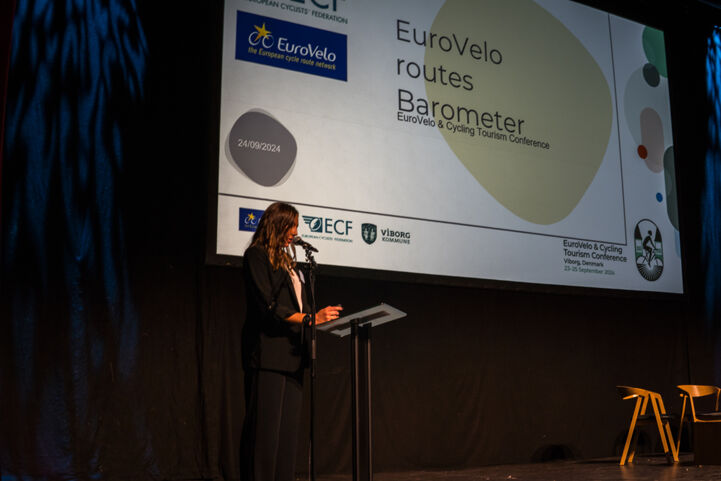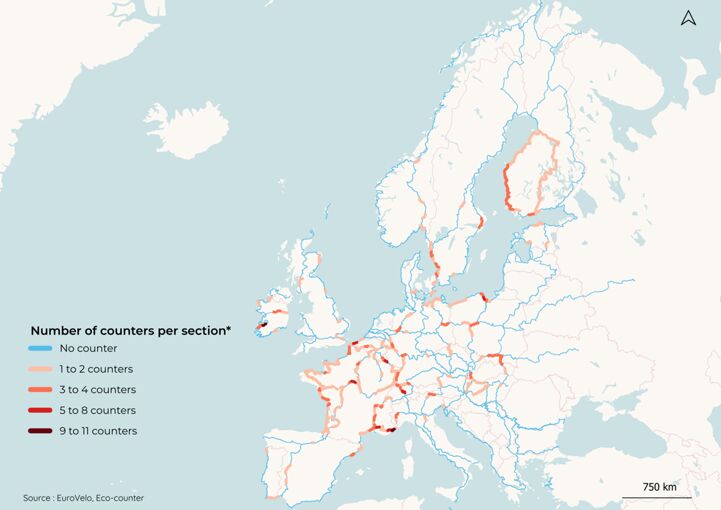Cycling counts in Europe: numbers from the EuroVelo Usage Barometer show stability for 2024
The European Cyclists' Federation and Eco-Counter work together since 2020 to gather data about the usage of EuroVelo routes using a sample of counter installed all across Europe. We monitor data at the beginning of each calendar year and at the end of the summer season. The data of the EuroVelo Usage Barometer is part of the EuroVelo Data Hub.
Stable bicycle traffic between 2023 and 2024
+0.6% – that’s the small increase recorded by a representative sample of 540 automatic bicycle counters on European cycle routes between January and August 2023 and the same period in 2024.
This analysis based on Eco-Counter’s network of automatic counters was presented at the EuroVelo & Cycling Tourism Conference to assess the latest season on EuroVelo routes. The 2024 results show a stabilisation in the use of the EuroVelo routes, which could partly be explained by less clement weather than 2023.
You can access the full presentation by Eco-Counter's Alice Kervran at the EuroVelo & Cycling Tourism Conference 2024 at this link.

Urban areas up, suburban areas down
However, this stability masks different realities in different zones. Thanks to a European-wide effort of public authorities (cities, councils, etc.) in installing and maintaining bicycle counters, a total of 540 sites was analysed for this year’s edition.
Those 540 sites surveyed were classified by type: rural, urban or suburban environment, to compare their respective trends. Interestingly the sample of counters includes one third of each environment: urban, periurban, rural. While practice in rural and urban areas is on the rise (1.4% and 1.3%), peri-urban is down slightly (-0.7%). This is a sign that more promotion of cycling and cycle routes to residents and potential tourists is needed to achieve the ambitious objectives of national and European cycling plans.
A few itineraries are still doing well, including the Atlantic Coast Route
While overall ridership on the EuroVelo network has been growing only marginally, EuroVelo 14 – Waters of Central Europe, EuroVelo 11 – East Europe Route and EuroVelo 1 – Atlantic Coast Route are recording a significant increase in traffic between 2023 and 2024. The latter is recording a 6% growth in Europe between 2023 and 2024.
Methodology
Eco-Counter, which has been providing counting systems since 2000, relied on a set of 540 representative counting sites throughout the EuroVelo network installed by relevant authorities, most of the time regions and municipalities. This is a significant growth of the sample compared to previous analysis which were based on 2019 as a reference year (the 2023 report was based on a sample of 195 counters). The sample is still not covering all the EuroVelo network but improves the accuracy of the analysis by including more counters from certain countries (e.g. Austria, Finland, Hungary, Poland, Switzerland, the UK, etc.).

The distinction between “Urban”, “Suburban” and “Rural is established using the location of each counting site in combination with information on the geographic unit LUA and the degree of urbanization (DEGURBA).
Cover image: EuroVelo 11 in Hungary.